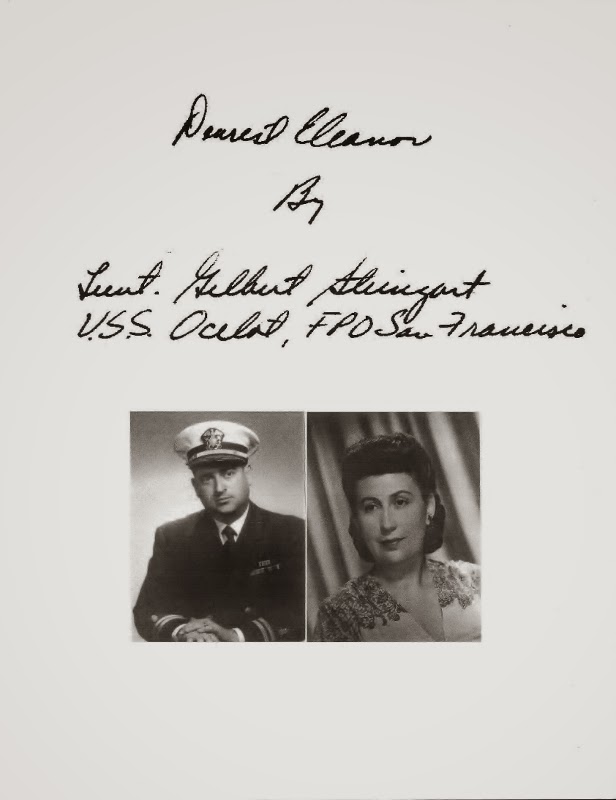Saturday 29 January 1990
Friends and family gathered to
celebrate Gil's 90th birthday. On the day of his actual birthday, he and his friend Sandy were on a
trip around the world. His
recollections don't jibe with the letters he wrote 55 years earlier. The story of the two typhoons had morphed into one. The following is a transcipt of conversation at the party:
GIL: January is a big
month for me. I was born in January. Then
in 1943 the navy called me, and I entered in January. Then in 1946 January, the
navy was very very generous in allowing me to return to civilian life. January
is a big month. Here I am in January again. If I'd waited another couple of
days we'd be out of luck. Anyhow. Maybe next year in January we can do it again.
GEORGE SEEDS JR.: Tell us a navy story.
GIL: No navy stories tonight
GEORGE SEEDS SR.: Tell us about the typhoon and how you got
off the ship and all that kind of crap.
GIL: Navy typhoon.
DEBBY GINDOFF: It's
true.
GIL: It's a miserable story but you know we sailed from
Leyte Gulf in the Philippines. We were heading for Tokyo. Got to Okinawa. Something was the matter with
the screw they said so we had to repair it.
QUESTIONER: What kind
of ship was it?
GIL: Well we were on
DEBBY: A flagship.
GIL: A flagship? It was old freighter that had been
converted to the flagship for the service squadron. The damn thing could go twelve knots when you had the thing
wide open and then it would go for awhile and go phfft. We were under repairs when we got the warning that we were having a typhoon
heading for Buckner bay in Okinawa. Any
ship that was able to get up steam they got out. Everyone who could get out got out.
We couldn't get out so we put anchors on one end of the ship
and another anchor on the end of the ship. As the typhoon came in the anchors
wouldn't hold. We were torn lose. Then we started to go ahead. Anywhere the wind
went we went.
They blew one way and other way. Finally. The skipper knew, according to the
charts, that a reef was there. So he figured we'd head up on the reef and we'd be okay.
He headed up on the reef. The elements were not in favor of it, turned the ship around. There we were sitting on a reef. Every time the sea hit us we rolled back and
forth . Back and forth.
QUESTIONER: Were you
scared? Actually, I didn't know what was happening so I couldn't be scared.
GEORGE SR : Typical navy.
GIL: This is not the
end of the story. The wind blowing blew
in a little patrol vessel that had some depth charges. The skipper of that ship wanted to get rid of
the depth charges so he dumped
them over the side. And as our ship
rolled back and forth, it rolled over and it triggered one of the depth charges. That's
not bad cause we're sitting on a reef.
The wind is still blowing and here comes an LSM (landing
ship with troops on it) starts
heading in and plows into the hole that was blown open and that cut us in half.
At that time the skipper called me up to the bridge and he said you and the medical doctor are abandoning ship and you are going over the side
and going ashore so when casualties occur we'd be there.
I had on an old Mae West. I had to go down to the office. Got
the medical records. Threw them over one shoulder and some other records over
the other shoulder.
Went over to the rail and looked down. There was a little raft big enough for 2 people. The skipper wanted me and the medical officer
to go down to that raft. Well it was 60
feet down. I had never gone down a line
in my life. I'll guarantee if you watched me you'd have said I'd been doing it my
whole life.
But anyhow as I
started going down the ship anytime the
ship would roll over, I'd look in at
nothing but water. When we got up I
could see that raft again. Got down onto the raft. This raft by some kind of a system they had they had shot a breeches buoy ashore and had raft tied to a line that
was going to pull us to the shore, that was 100 yards or so.
The medical officer and I got into this was a foam raft with
slats on the bottom. They started bringing us in. Every time the
sea would raise us up and put us down on the coral would work on the bottom. It
didn't long before no bottom was left.
Our legs were hanging down in the cork raft. Every time we went down we'd pick up more
coral. The medical officer and I decided this is not a very good idea. So we got out of the raft, got a hold of
the line and pulled us into the shore.
QUESTIONER: What happened to the boat?
GIL: Who knows? And that's my story.
DEBBY: Did you have any casualties to take care of
afterwards? No casualties thank God.
Our ship was lined up with a whole bunch of ships that were
all piled up together. the sailors were going from one ship to the next to get
ashore. And I had a beautiful
collection of seashells. That was gone. Nothing
else went. This was something that
appealed to the sailors, so they picked it up.
Anyhow. That's my story of being shipwrecked.
From Tribute to
Gil Steingart
DVD (2003) by Verna Harvey
Gindoff
Links to the original accounts of the two typhoons are below:
TYPHOON IDA
TYPHOON LOUISE









